



We call the convexity of a function \(f\) its general shape, rather bowl-shaped (convex) or rather cellar-shaped (concave).
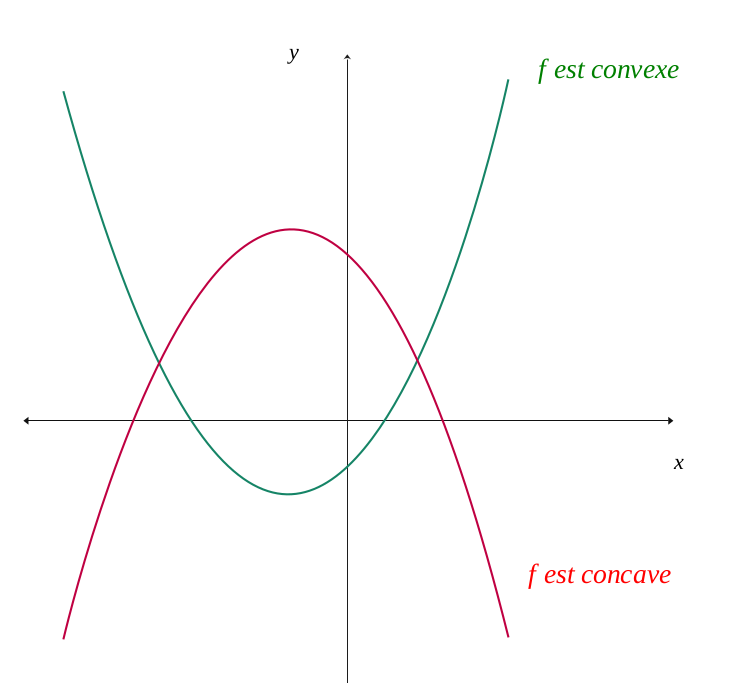
We define it more precisely according to the position of its tangents and the chords of the function.
Let \(f\) be a function of class \( \mathbb{C}^{2}\) on its definition set \( D_f \) and any interval \(I\).
Just as the derivative indicates the direction of variation of a function, the sign of the second derivative indicates convexity.
And,
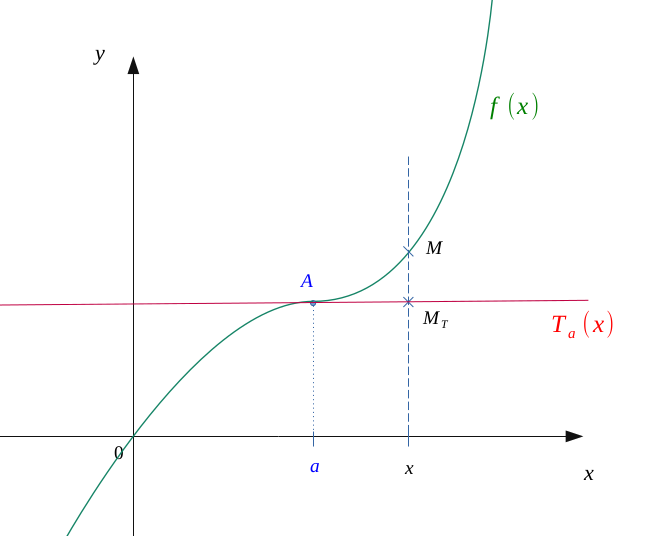
A function \( f \) is said to be convex on an interval \( I \), if any tangent at a point lies below the curve. A contrario, it is concave if any tangent is located above the curve.
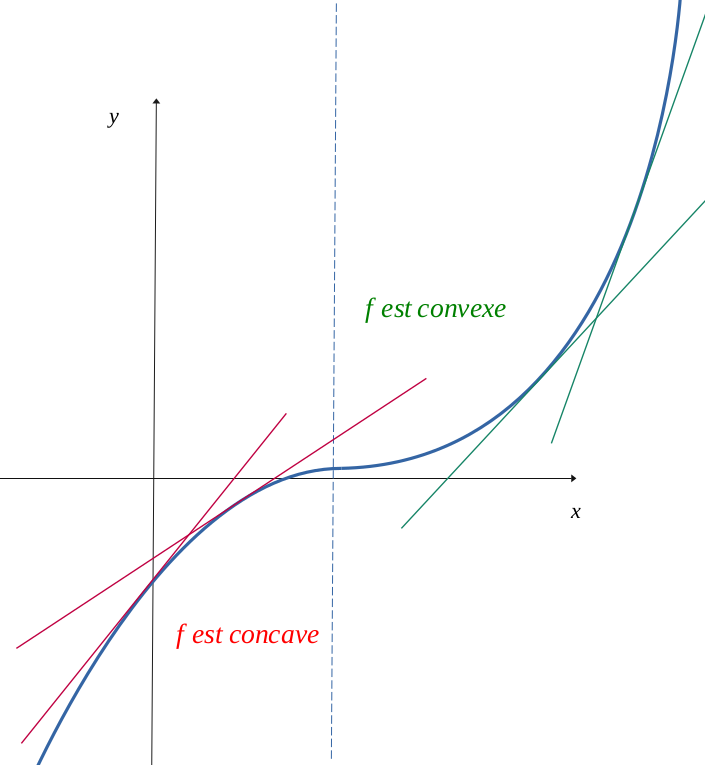
A function \( f \) is said to be convex on an interval \( I \), if any rope which connects two points of this interval lies above the curve. A contrario, it is concave if any rope is located below the curve.
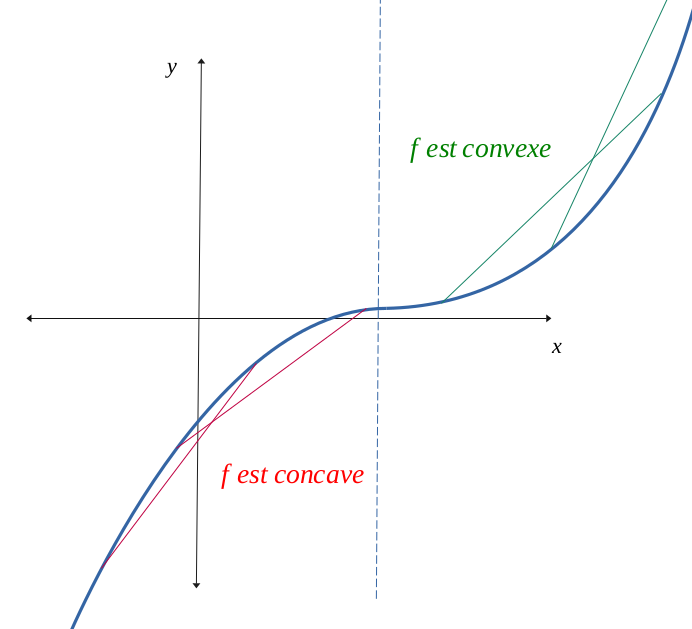
Let \(f\) be a function of class \( \mathbb{C}^{2}\) on its definition set and its tangent at a fixed point \(a\).
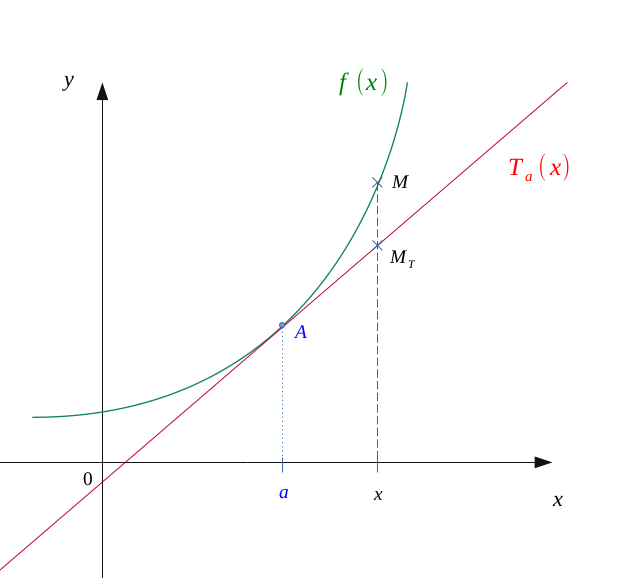
Let us seek to determine hte position of its tangent according to the nature of \(f\).
Let be two mobile points \(M(x;\ f(x))\) and \(M_T(x; \ T_a(x))\) depending on \(x\), respective images of \(f\) and the one of \(T_a\) at point \(x\).
The tangent equation \(T_a\) is worth:
So, point \(M_T\) will have the coordinates:
Let us now consider a new function \(g\), being worth the difference between \(f\) and \(T_a\):
To determine which of the two is above the other one, we must study the sign of \(g\) at the neighborhood of \((x=a)\), value for which the function g vanishes.
Function \(f\) being derivable twice by hypothesis and \(T_a\) being of class \( \mathbb{C}^{\infty}\), function \(g\) is also derivable twice, and:
With \((g)\), \((g')\) and \((g''')\), we then have:
Let us assume that it is possible to find a positive number \(\eta\) such as:
Which means that \(f''\) is supposed to be positive for the values to the left and right of \(a\). Except for \(x=a\), as clearly indicated \((S_+)\) because there may be cases where \(f''(a)\) will be infinite or even not defined at all.
This assumption made, we see with \((g'')\) that, this also entails \(g'' > 0\) to the left and right of \(a\) with \(g''(a) = 0\).
Then the derivative \(g'\) will be increasing to the left and right of \(a\), with \(g'(a) = 0\).
We will then have to the left and right of \(a\):
$$ \left \{ \begin{gather*} \Bigl[ \ x < a \ \Longleftrightarrow \ g'(x) < 0 \ \Bigr] \ \Longleftrightarrow \ g \text{ is decreasing for } (x < a) \\ \Bigl[ \ x > a \ \Longleftrightarrow \ g'(x) > 0 \ \Bigr] \ \Longleftrightarrow \ g \text{ is increasing for } (x > a) \end{gather*} \right \} $$
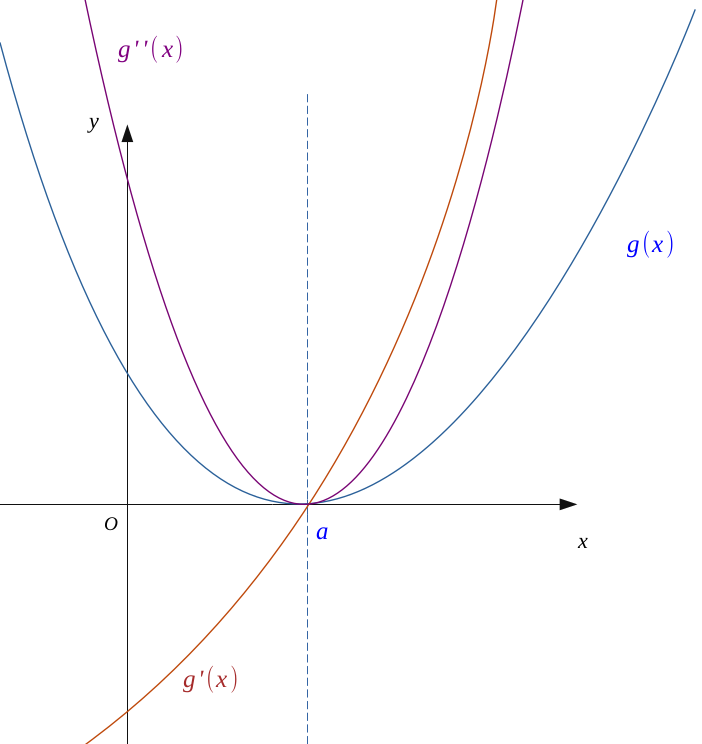
Which leads to \(g\) is decreasing on the left and increasing on the right of \(a\).
But \( g(a) = 0\), so \(g > 0\) left and right in the vicinity of \(a\).
We can conclude that for any interval \(I \):
It is possible to make the same demonstration by making the opposite supposition of \((S_+)\), namely:
So in this case \(g\) will be increasing to the left and decreasing to the right of \(a\), and we will have in the same way \(g < 0\) left and right in the vicinity of \(a\).
In the case where \( f''\) would have a different sign to the right and left of \(a\), there are then two cases.
Let us assume a first case, namely that \( f'' < 0\) to the left and \( f'' > 0\) on the right of \(a\). Then,
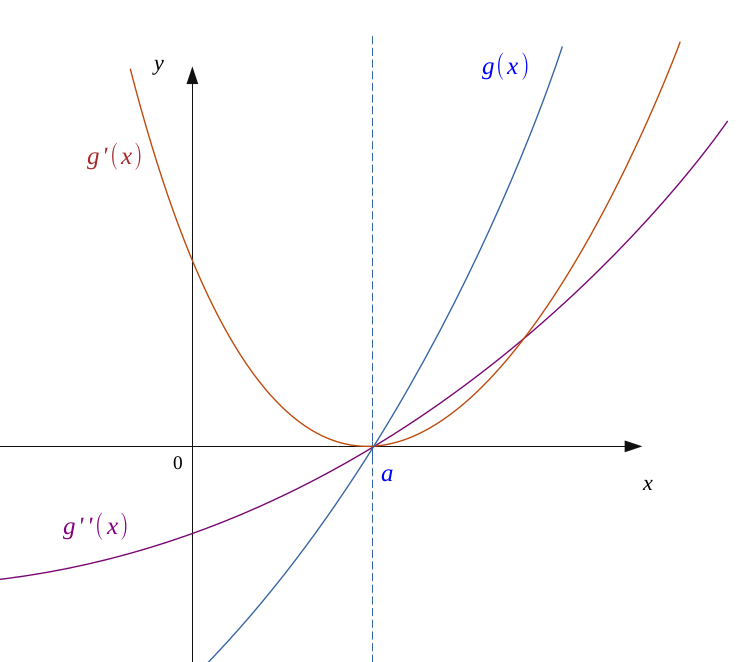
\(g'\) will be decreasing on the left then increasing on the right, which results in \(g'(x) > 0\).
So \(g\) will always be increasing and as \(g(a) = 0\), we will have \(g < 0\) to the left and \(g > 0\) on the right of \(a\).
We will then have an inflection point at point \(a\); which means \(f\) will change convexity.

As we have just shown previously that if the function \(f\) is convex, then the curve of the function is always above its tangents, i.e.:
Then,
Let \( f \) be a continuous and convex function on an interval \( I = \bigl[a,b \bigr] \), and a point \( c \in \bigl[a,b \bigr] \) of this interval, such as the following figure:
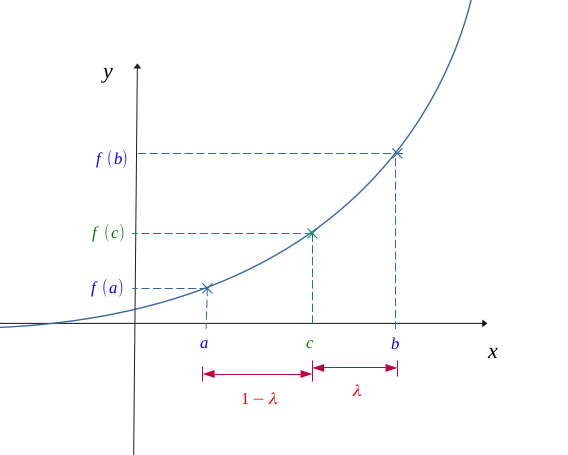
We introduce a real number \(\lambda\), proportion between points \( c \) and \( b \) according to the interval \( \bigl[a,b \bigr] \):
Consequently, we will have the other part which will be equal to:
In the following figure, we introduce a rope going from \( a \) to \( b\):
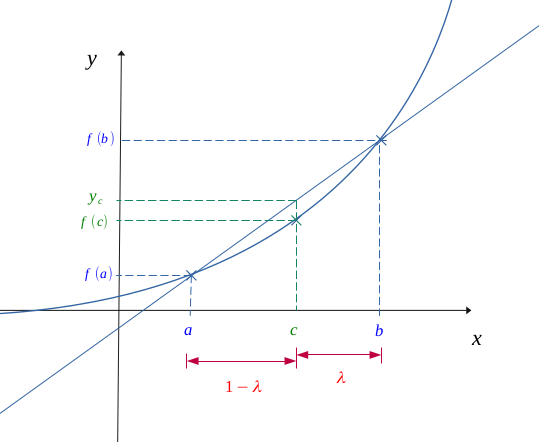
We will be able to locate the position of the rope in relation to the curve of \( f \) at point \( c \).
We then have:
With the equation \( (\lambda)\), we do have:
By performing a cross product:
Therefore, \( f(c) \) is worth:
By calculating the slope of the rope:
But:
So, replacing it by its value:
If the function \( f \) is convex, this means that for any point \( c \in \bigl[a, b\bigr] \), its image will always be below the point of the rope \(y_c\).
And finally,
We will say that \( f \) is concave if \( (-f) \) is convexe. Thus:
By multiplying both parts by \( -1 \):
Let's determine the convexity of the function \( f : x \longmapsto x^2 \) inside the interval \( [-1,1] \).
We will determine if there is any interval \( \lambda \in [0,1] \) which verifies one or the other convexity inequality.
We calculate in the interval \( \bigl[a, b \bigr] = [-1,1] \):
So,
We calculate in the interval \( \bigl[a, b \bigr] = [-1,1] \):
So,
To determine the relative position of these two functions, let's take their difference.
We can directly make a table of signs.
|
$$ \lambda $$
|
$$ -\infty $$
|
$$ \hspace{3em}$$
|
$$ 0 $$
|
$$ \hspace{3em}$$
|
$$1$$
|
$$ \hspace{3em}$$
|
$$ +\infty $$
|
|---|---|---|---|---|---|---|---|
|
$$ 3 \lambda $$
|
$$ - $$
|
$$ - $$
|
$$ 0 $$
|
$$ + $$
|
$$ + $$
|
$$ + $$
|
$$ + $$
|
|
$$ \lambda - 1$$
|
$$ - $$
|
$$ - $$
|
$$ - $$
|
$$ - $$
|
$$ 0 $$
|
$$ + $$
|
$$ - $$
|
|
$$ (g-h)(\lambda) $$
|
$$ + $$
|
$$ + $$
|
$$0 $$
|
$$ - $$
|
$$ 0 $$
|
$$ + $$
|
$$ -$$
|
We definitely have for all \( \lambda \in [0, 1], \enspace (g-h)(\lambda) \leqslant 0\).
It means that:
The ropes are above the curve, the function is convex.
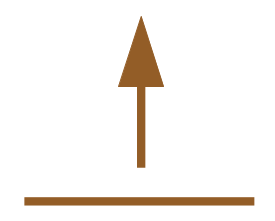 Go to the top of the page
Go to the top of the page